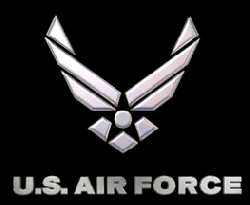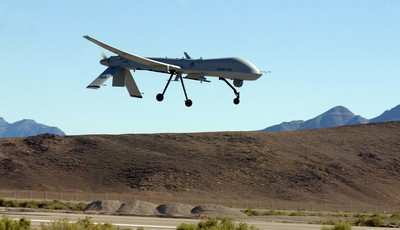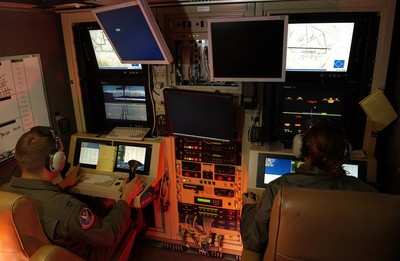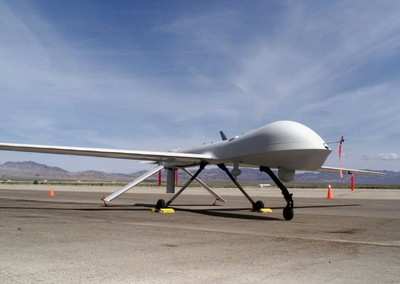 Airmen who operate and fly the MQ-1B
Predator are tired, but you couldn’t tell that by the
unprecedented 27,000 hours the Predator has flown this past year
supporting operations Enduring Freedom and Iraqi Freedom.
Airmen who operate and fly the MQ-1B
Predator are tired, but you couldn’t tell that by the
unprecedented 27,000 hours the Predator has flown this past year
supporting operations Enduring Freedom and Iraqi Freedom.
Some in the 15th Reconnaissance Squadron at Nellis Air Force
Base, Nev., believe they are the only flying squadron in the Air
Force that can even come close to logging that many flying hours.
From June 2004 to June 2005 the unit flew more than 27,000 hours,
breaking its own monthly record three of the past 12 months.
Comparatively, the unit flew nearly 20,000 hours in 2004 and 9,500
in 2003.
“Our guys and gals are tired and don’t see a light
at the end of the tunnel,” said Lt. Col. M.E. Bannon, 15th RS
director of operations. “And when they are at
forward-deployed locations, they run hard, but do it for short
distances.”
But that is not the case at home station.
“There’s no sprinting here,” Colonel Bannon
said. “We’re on a marathon, and I’m trying to get
us through 26 miles without breaking the squadron, (our remotely
piloted aircraft) and the careers of 180 people.”
The aircraft’s biggest challenge is that it is too
popular. Back in 1995, when the Predator made its first appearance
during Operation Joint Endeavor in Taszar, Hungary, the Air Force
did not foresee just how popular the aircraft would become. During
its first appearance, the Predator’s main function was to spy
on the enemy. In time, it changed. As it evolved, its mission
expanded.

From 1995 to 2000, the Air Force used the aircraft primarily for
intelligence, surveillance and reconnaissance. In 2001, its mission
included counterland missions with a laser beam to point out
targets and help fighter pilots to their objectives. Shortly after
that, the Air Force equipped the Predator with the ability to carry
AGM-114 Hellfire missiles capable of piercing armor.
From then on, ground troops cannot seem to get enough of the
Predator.
“The Predator prepares warfighters prior to their
operations,” Colonel Bannon said. “The combatant
commanders know what to expect, and they like up-to-date pictures
of the battlefield.”
Remote operations video enhanced receivers allow the Predator to
share what it sees by feeding real time, full motion video to other
airplanes or ground troops. Everyone sees what it sees.
“The Army and Marines have an insatiable appetite for
full-motion video the Predator supplies,” Colonel Bannon
said. “Currently, there is a daily request for more than 300
hours of video a day, and we can only provide about 110 hours --
that’s a big shortfall.”
Additional Predator missions include ISR, close-air support,
interdiction, damage assessment, combat search and rescue, force
protection (locating improvised explosive devices) and remote
operations video enhanced receivers operations.

“We’re discovering IEDs before they do damage to our
troops,” the colonel said. “It’s not uncommon
when we catch the bad guys planting the devices, or tag a location
for the disposal ordnance teams to go disarm it. We’re
keeping Soldiers and Marines alive.”
With few pilots and so much demand, the only way the 15th can
complete its missions is reverting to what they call remote split
operations, which involves operating the Predator from a
ground-control station at Nellis while crewmembers at deployed
locations handle the launches and landings. Once airborne at high
enough altitude, control of the aircraft is given to operators in
the states. It creates a huge savings in manpower.
“We’d have to have 200 pilots to do what we do in
Operation Iraqi Freedom and Operation Enduring Freedom. By using
remote split operations, we can fly more than 3,000 hours per month
from Nellis,” Colonel Bannon said.

By flying combat operations from one location in two theaters of
war, the 15th RS has proven it can do more with less, and the light
at the end of the tunnel will grow bigger as the Air Force obtains
more Predators and Predator aircrew, Colonel Bannon said. [ANN
Salutes Master Sgt. Orville F. Desjarlais Jr., AFPN]
 ANN's Daily Aero-Linx (04.16.24)
ANN's Daily Aero-Linx (04.16.24) Aero-News: Quote of the Day (04.16.24)
Aero-News: Quote of the Day (04.16.24) Airborne 04.10.24: SnF24!, A50 Heritage Reveal, HeliCycle!, Montaer MC-01
Airborne 04.10.24: SnF24!, A50 Heritage Reveal, HeliCycle!, Montaer MC-01 Airborne 04.12.24: SnF24!, G100UL Is Here, Holy Micro, Plane Tags
Airborne 04.12.24: SnF24!, G100UL Is Here, Holy Micro, Plane Tags Airborne-Flight Training 04.17.24: Feds Need Controllers, Spirit Delay, Redbird
Airborne-Flight Training 04.17.24: Feds Need Controllers, Spirit Delay, Redbird






